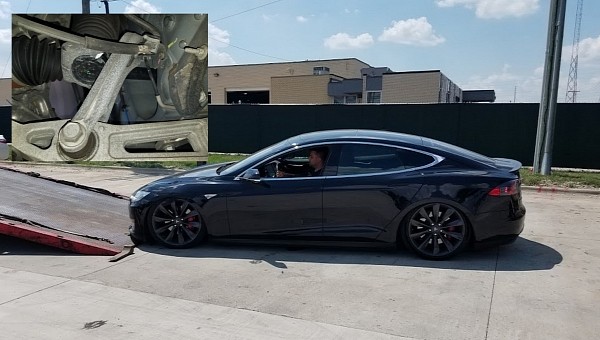On October 25, we brought our readers what seemed to be the first video showing how “whompy wheels” act in a Tesla vehicle. A crash in Sandbach, UK, was filmed by a passerby with a dashcam, and it shows the right front wheel was broken before the crash happened. We thought it was the first video evidence of the chronically defective suspensions in Tesla vehicles, but we were wrong. There is an earlier video showing a Tesla suspension failing.
The video was posted on the TMC with an extensive explanation of what happened on July 7, 2020. The user ChefAries stated that his 2016 Tesla Model S P90D – with only 35,000 miles on the clock – was driving on Eisenhower Expressway (Interstate 290) in Chicago when “a huge bang violently shook the car, as if I ran over a huge pothole." His video shows it all occurred on the same day, at 1:17 PM, close to Exit 13 A.
The impact dropped the “dashcam off its suction mount.” The video proves that when the camera seems to hang and swing while the driver tries to recover control of the EV. When ChefAries got out of his Model S, the left side of his car was “slammed to the ground” while the fender was “riding on the tire.”
ChefAries managed to drive his car to a nearby parking lot to take a look. He then realized the steering knuckle casting was fractured at the bottom of the air spring. Tesla Roadside assistance told him there was “nothing remotely wrong” with his car, which forced him to pay to tow his EV. Luckily for him, he had the video to prove everything.
That did not prevent ChefAries from hearing that the cause was an aftermarket sensor that made the car lower than it should be. He wondered why that would make a suspension break but argued that he had never changed anything in the car since he bought it around September or October 2021.
Tesla eventually said it would cover the repairs, which demanded “new air spring, new brake lines, new sensors, and a new wheel/tire.” The estimate was $6,000. Although he was relieved, he was afraid that would happen in the other wheels, too, because they all had different sensors. Little did he know that the problem would become more widespread.
Several other suspension components break in Tesla vehicles, including in the Model 3 and Model Y. A Swiss Model S owner saw the lower control arm break at 200 kph (124 mph) on a German Autobahn. The Model 3 and Model Y had suspension recalls, and the Chinese government forced Tesla to replace some components in China with the Model S and Model X. As you can see, Keef Wivaneff did not coin the expression “whompy wheels” by chance.
Hat tip to Ton Aarts!
The impact dropped the “dashcam off its suction mount.” The video proves that when the camera seems to hang and swing while the driver tries to recover control of the EV. When ChefAries got out of his Model S, the left side of his car was “slammed to the ground” while the fender was “riding on the tire.”
ChefAries managed to drive his car to a nearby parking lot to take a look. He then realized the steering knuckle casting was fractured at the bottom of the air spring. Tesla Roadside assistance told him there was “nothing remotely wrong” with his car, which forced him to pay to tow his EV. Luckily for him, he had the video to prove everything.
That did not prevent ChefAries from hearing that the cause was an aftermarket sensor that made the car lower than it should be. He wondered why that would make a suspension break but argued that he had never changed anything in the car since he bought it around September or October 2021.
Tesla eventually said it would cover the repairs, which demanded “new air spring, new brake lines, new sensors, and a new wheel/tire.” The estimate was $6,000. Although he was relieved, he was afraid that would happen in the other wheels, too, because they all had different sensors. Little did he know that the problem would become more widespread.
Several other suspension components break in Tesla vehicles, including in the Model 3 and Model Y. A Swiss Model S owner saw the lower control arm break at 200 kph (124 mph) on a German Autobahn. The Model 3 and Model Y had suspension recalls, and the Chinese government forced Tesla to replace some components in China with the Model S and Model X. As you can see, Keef Wivaneff did not coin the expression “whompy wheels” by chance.
Hat tip to Ton Aarts!
Sommige Tesla beliebers vragen mij wel eens
— Ton Aarts (@ton_aarts) July 11, 2020
'Ton. Hoeveel van die speculaas Tesla wielophangingen zijn er nou al afgebroken?
En heb jij beeld ervan, als bij Tesla met pas 35.000 mijl op teller de zoveelste wielophanging pats! afbreekt, midden op snelweg?'
Honderden, zeg ik dan pic.twitter.com/oicLBsWfwK







